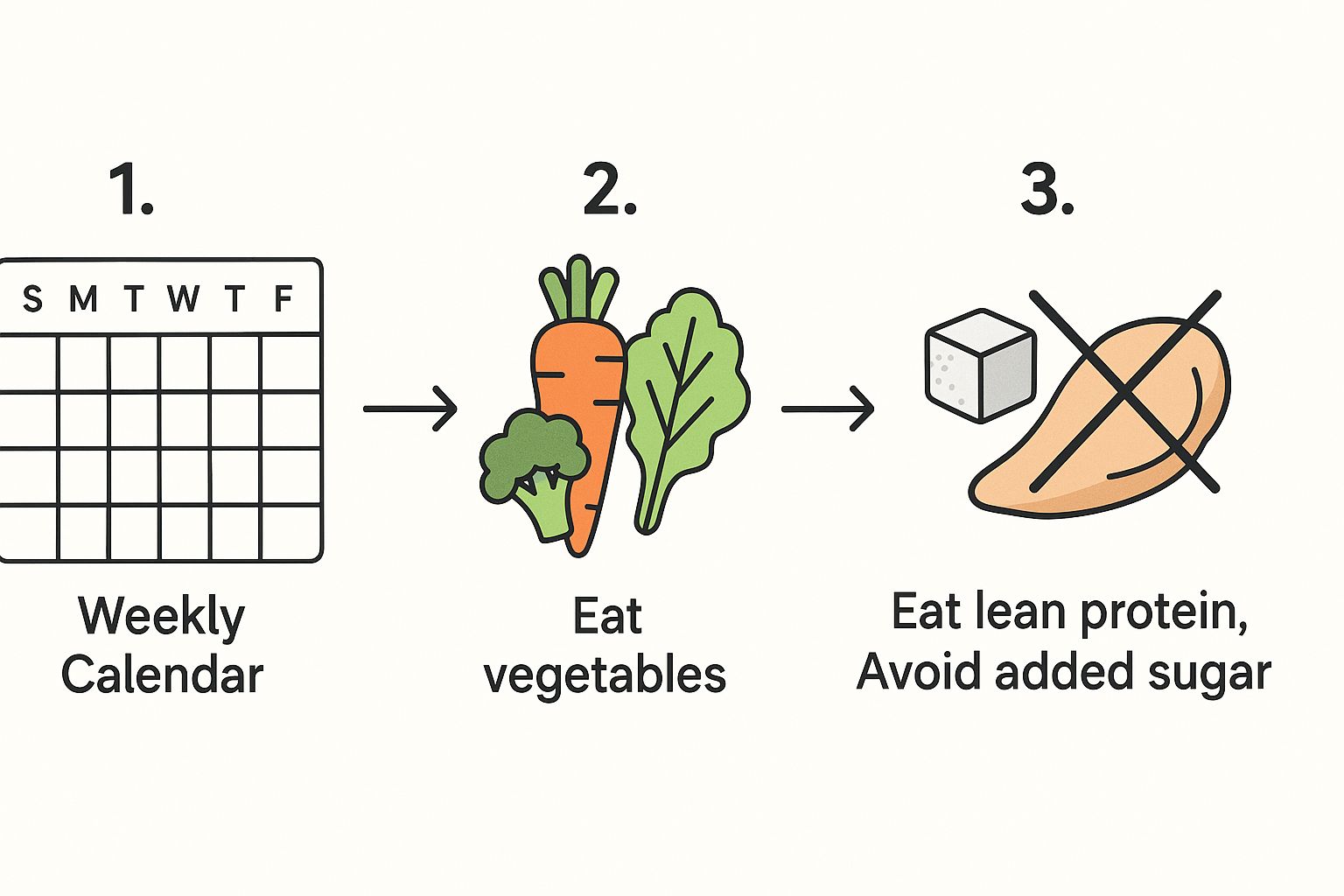A Sugar Free Diet Plan That Actually Works

A sugar-free diet plan isn't about deprivation. Far from it. Think of it as a smart way of eating that cuts out the added sugars and instead, fills your plate with whole, unprocessed foods. The real goal is to get back to eating food in its most natural state, which helps stabilize your energy, lifts your mood, and sets you up for better long-term health.
Setting the Stage for a Sugar-Free Lifestyle

Before you even think about recipes or meal prep, let's get one thing straight about what "sugar-free" actually means. We're not talking about avoiding the natural sugars you'd find in a crisp apple or a glass of milk. Those come with fiber, vitamins, and other good stuff that helps your body use them for steady energy, preventing that dreaded sugar crash.
The real culprit we're targeting here is added sugars. These are the sweeteners—often refined—that manufacturers sneak into an unbelievable number of products. You'll find them lurking in obvious places like soda and candy, but also in savory foods like pasta sauce, salad dressings, and even "healthy" yogurts. Cutting these out is your first and most important mission.
This isn't just a fleeting trend. People are waking up to the benefits. The sugar-free food market was valued at USD 45.32 billion recently and is expected to soar to USD 83.20 billion by 2034. This growth is fueled by a collective understanding of how sugar contributes to chronic health issues. You can dive deeper into the numbers by exploring the full market analysis on towardsfnb.com.
The Real-World Benefits Beyond the Scale
While many people start this journey to lose weight, the most surprising benefits often have nothing to do with the number on the scale. People who make the switch often report feeling better in ways they didn't expect.
- More Stable Energy: Kiss that 3 PM slump goodbye. When you stop riding the sugar rollercoaster, your energy levels stay consistent all day long.
- Improved Mental Clarity: That feeling of brain fog is often tied to blood sugar instability. Many find they can focus and concentrate much better without sugar.
- Better Moods: Your diet directly impacts your mood. A steady supply of good fuel can lead to a more stable and positive disposition.
- Clearer Skin: For some, high sugar intake triggers inflammation that shows up as acne or other skin problems.
This is about shifting your mindset from restriction to empowerment. Once you truly understand how certain foods affect your body, choosing the healthier option feels like an act of self-care, not a sacrifice. That's the key to making this a lasting change, not just a temporary diet.
How to Spot Hidden Sugars
Food manufacturers have gotten pretty sneaky. They use dozens of different names for sugar on ingredient lists to fly under the radar. Your new superpower will be becoming a "sugar detective."
The quickest way to bust them is to find the "Added Sugars" line on the nutrition label. It’s a dead giveaway. But to be truly savvy, you need to learn sugar's many aliases.
Knowing what to look for in the fine print of an ingredients list is a total game-changer. Here’s a quick guide to some of the most common names they use.
Common Hidden Sugars on Food Labels
| Category | Common Names for Sugar |
|---|---|
| Syrups | High-fructose corn syrup, corn syrup, maple syrup, agave nectar, rice syrup, malt syrup |
| "-ose" Suffixes | Sucrose, glucose, fructose, dextrose, lactose, maltose |
| Natural-Sounding Sugars | Honey, molasses, date sugar, coconut sugar, evaporated cane juice, fruit juice concentrate |
| Other Names | Barley malt, caramel, diastatic malt, ethyl maltol, panela |
Keep this list handy when you're grocery shopping. You’ll be surprised at where sugar is hiding once you know what to look for. Reading labels becomes second nature after a while, and it’s the most critical skill for sticking with a sugar-free lifestyle.
How to Stock Your Sugar Free Kitchen
Let's be honest, going sugar-free isn't just about willpower. A huge part of your success is decided long before a craving hits—it's won in the grocery store aisle.
Think of it this way: you want to set up your kitchen so that the healthy choice is the easy choice. That means a little planning and a strategic kitchen overhaul. We're going to clear out the tempting stuff and stock up on foods that are not only compliant but genuinely delicious.
Forget about a restrictive mindset. Let's focus on the incredible variety you get to enjoy.
Building Your Foundation with Whole Foods
Your shopping cart is basically the blueprint for your new way of eating. The easiest trick? Stick to the perimeter of the grocery store. This is where you’ll find all the fresh, whole foods that should make up the bulk of your diet.
- Fresh Produce: Don’t be shy here. Load up on non-starchy vegetables like leafy greens (spinach, kale), broccoli, cauliflower, bell peppers, and zucchini. When it comes to fruit, stick with lower-sugar options like berries, a crisp apple, or citrus.
- Quality Proteins: Make sure you have plenty of eggs, chicken breast, lean ground turkey, and fish like salmon or cod. These are your power players for staying full and keeping your blood sugar steady.
- Healthy Fats: Avocados are your best friend. So are nuts like almonds and walnuts, seeds (chia, flax, pumpkin), and a good bottle of olive oil. Fats add rich flavor and are crucial for feeling satisfied after a meal.
Your kitchen should feel like a sanctuary, not a battlefield. When your fridge is stocked with fresh vegetables and your pantry has healthy snacks, you remove the daily decision fatigue that often leads to grabbing something sugary.
Mastering the Pantry Staples
The center aisles can feel like navigating a minefield of hidden sugars. This is where you need to become a bit of a detective and get really good at reading labels. But don't worry, there are plenty of fantastic staples here.
Your new go-to pantry items should include:
- Legumes and Whole Grains: Think canned beans (black, chickpeas, kidney), lentils, quinoa, and rolled oats. These are awesome sources of fiber. Just make sure you grab the canned goods packed in water, with no added salt or sugar.
- Flavorful Spices and Herbs: So often, sugar is just used to cover up bland food. It's time to build a killer spice rack. Cinnamon, cumin, smoked paprika, garlic powder, and dried herbs like oregano and basil will become your new best friends.
- Compliant Condiments: You don't have to give up flavor! Look for no-sugar-added marinara sauce, mustard, vinegars (apple cider is great), and full-fat canned coconut milk for making creamy, decadent sauces.
You’re not alone in making this switch. The beverage aisle is a perfect example of this shift. The market for zero-sugar drinks exploded from USD 3.33 billion to an estimated USD 4.35 billion in just one year. It's proof that people are actively looking for better options. You can discover further insights into the zero-sugar beverage market on futuremarketinsights.com to see just how big this trend has become.
When you start focusing on these core food groups, grocery shopping stops being a chore. It becomes a strategic part of your success. You aren't just buying food; you're stocking up on future energy, mental clarity, and well-being.
A 7-Day Sugar-Free Meal Plan To Get You Started
Starting any new eating style can feel like a huge challenge. The best way I've found to make it stick is to have a clear, simple plan for that first week. This isn't about rigid rules; it's about having delicious, satisfying options ready to go so you're not left wondering what to eat.
Think of this as your roadmap, not a strict itinerary. You can easily swap days around or substitute a meal with another favorite. The goal is to build momentum with simple, whole-food recipes that are genuinely easy to make and taste great.
Here's a look at how a week of eating well—focused on lean protein, colorful veggies, and healthy fats—can come together without any added sugar.

This just goes to show how simple choices, made consistently, can completely reshape your plate and crowd out those sugary habits for good.
Getting Through The First Few Days
The beginning is all about setting yourself up for success. We'll lean on protein-packed breakfasts and lunches you can make ahead of time. This is a game-changer for busy weekdays.
- Day 1: Kick things off with two muffin-tin mini quiches (I like using eggs, spinach, and mushrooms). For lunch, a fresh Caprese avocado toast on good whole-grain bread hits the spot. Dinner is zucchini noodles with avocado pesto and sautéed shrimp—light, but surprisingly filling.
- Day 2: A slice of whole-grain toast topped with creamy mascarpone and fresh berries feels like a treat. Lunch is leftover spinach and feta turkey meatballs served with some herbed quinoa. Come dinnertime, a pistachio-crusted salmon fillet with roasted broccoli is simple and elegant.
- Day 3: Let your meal prep do the work! Grab two more mini quiches for breakfast. Lunch is another round of the turkey meatballs with quinoa. For dinner, try a quick whole-grain spinach ravioli with artichoke hearts and olives.
My best advice? Spend just an hour on Sunday prepping the mini quiches and turkey meatballs. It might seem like a chore, but this little bit of effort saves you so much mental energy during the week and keeps you from grabbing something you'll regret.
Keeping The Momentum Mid-Week
By this point, you're likely starting to feel a bit more energetic as your body adjusts. Let's keep things interesting with some new flavors.
- Day 4: Breakfast is another easy win with your pre-made mini quiches. Lunch is leftovers again: turkey meatballs with quinoa. For dinner, we're going plant-based with grilled cauliflower steaks with almond pesto and butter beans.
- Day 5: Let's switch it up for breakfast with mascarpone and berries toast. Lunch is the last of your delicious turkey meatballs. For dinner, you can throw together a quick and tasty charred shrimp, pesto, and quinoa bowl.
Finishing The Week Strong
You've made it to the weekend! These meals feel a bit more fun but still keep you completely on track with your sugar-free goals.
- Day 6: Grab your last two mini quiches for a quick breakfast. Lunch is a creamy avocado and white bean wrap using a whole-grain tortilla. Dinner is something the whole family will love: cauliflower chicken nachos, where you use roasted cauliflower florets instead of chips.
- Day 7: End your first week with that delicious mascarpone and berries toast. For lunch, have another avocado and white bean wrap. Your final dinner is a comforting classic: zucchini lasagna rolls stuffed with ricotta and a good sugar-free marinara sauce.
Don't forget about snacks! They are your secret weapon against cravings. A handful of walnuts, a clementine, or some homemade peanut butter-date energy balls are all fantastic choices.
One-Week Sugar-Free Meal Idea Matrix
To make it even easier to visualize and mix things up, here's a table laying out the week's meals. Feel free to swap a dinner from Tuesday with one from Friday if it works better for your schedule!
| Day | Breakfast | Lunch | Dinner | Snack |
|---|---|---|---|---|
| Day 1 | Muffin-Tin Mini Quiches | Caprese Avocado Toast | Zucchini Noodles with Shrimp | Handful of walnuts |
| Day 2 | Mascarpone & Berries Toast | Spinach & Feta Turkey Meatballs | Pistachio-Crusted Salmon | Clementine |
| Day 3 | Muffin-Tin Mini Quiches | Spinach & Feta Turkey Meatballs | Spinach Ravioli with Artichokes | Apple slices with almond butter |
| Day 4 | Muffin-Tin Mini Quiches | Spinach & Feta Turkey Meatballs | Grilled Cauliflower Steaks | A hard-boiled egg |
| Day 5 | Mascarpone & Berries Toast | Spinach & Feta Turkey Meatballs | Charred Shrimp & Pesto Bowl | A small bowl of mixed berries |
| Day 6 | Muffin-Tin Mini Quiches | Avocado & White Bean Wrap | Cauliflower Chicken Nachos | Peanut butter-date energy balls |
| Day 7 | Mascarpone & Berries Toast | Avocado & White Bean Wrap | Zucchini Lasagna Rolls | Celery sticks with cream cheese |
As you can see, a sugar free diet plan is far from boring. This first week is all about proving to yourself that you can eat incredible food, feel great, and hit your goals—all without the added sugar.
Navigating Cravings and Social Situations
Let's be real—life doesn't happen in a perfectly controlled kitchen. A successful sugar-free diet plan has to work for real-world situations like birthday parties, dinners out, and those inevitable stressful workdays. These moments are often the biggest hurdles, but with a bit of know-how, you can handle them gracefully and stay on track.
It’s totally normal to feel a little awkward at first. When your coworker offers you a slice of birthday cake, you don't need to launch into a full monologue about your diet. A simple and polite, “No thank you, it looks delicious though!” usually does the trick. If you’re comfortable, you can always add, “I’m not eating sugar right now, but I really appreciate the offer.”
The secret weapon here is planning. If you know you're heading to a potluck, bring a delicious sugar-free dish you genuinely love. That way, you're guaranteed to have something satisfying to eat while also contributing to the meal. Think vibrant salads, a tray of beautifully roasted vegetables, or a flavorful chicken dish.
Conquering Sugar Cravings Head-On
Cravings are a biological reality, especially when you're just starting out. Your body is re-calibrating, and your brain is missing its usual quick hit of dopamine from sugar. Just knowing this can give you the power to manage those urges without caving.
Here are a few practical ways to fight back when a craving strikes:
- Hydrate First: It's wild how often our brains mix up thirst and hunger signals. Before you grab a snack, try drinking a big glass of water and just wait a few minutes. You might be surprised.
- Have Go-To Snacks Ready: This is a big one. Keep compliant snacks handy, like a handful of almonds, an apple with nut butter, or a hard-boiled egg. Having a good option within reach prevents you from grabbing the nearest sugary thing out of pure desperation.
- Practice the Pause: When a craving hits, just stop for a second. Acknowledge the feeling without judging yourself for it, and then try a quick distraction—a short walk outside or even just a few deep breaths can work wonders.
You're not weak for having cravings; you're human. The goal isn't to never want sugar again, but to build the resilience to choose what's best for your body in that moment. For more in-depth strategies, check out our guide on how to stop sugar cravings.
Dining Out Without Derailing Your Progress
Staring down a restaurant menu can feel like a pop quiz you didn't study for, but it’s much easier than it looks. Most restaurants are more than willing to handle simple requests. Don't ever feel shy about asking your server how a dish is prepared or if a sauce can be served on the side.
Stick to simple, whole-food meals. Look for grilled or baked proteins like fish or chicken, and ask for steamed or roasted vegetables as your side. A big, satisfying salad with a simple oil and vinegar dressing is almost always a safe—and delicious—bet.
This shift toward less sugar is part of a much larger wellness movement. One major reason for this change is the staggering rise in health conditions like diabetes. The International Diabetes Federation recently reported that about 537 million adults were living with diabetes globally, a number that really highlights why dietary changes matter. You can learn more about the factors driving the sugar-free market on dataintelo.com. Mastering these social strategies is what makes a sugar-free lifestyle something you can stick with for the long haul.
Living a Sustainable Low-Sugar Lifestyle

Let's be real—the ultimate goal isn't to be on a strict diet forever. It’s about moving past a temporary sugar-free diet plan and settling into a way of eating that feels good, natural, and genuinely sustainable. This is where the real magic happens, when you transition from rigid rules to a more flexible, intuitive approach to food.
The biggest trap people fall into is the all-or-nothing mindset. It's that little voice in your head that says one cookie means you've completely failed. Forget that. A much healthier and more realistic approach is the 80/20 rule.
Basically, you focus on making great, whole-food choices 80% of the time. The other 20%? That’s your wiggle room for a birthday cake, a special dinner out, or a planned treat. This balance is what keeps you from burning out and makes a low-sugar lifestyle feel possible for the long haul.
Mindfully Reintroducing Foods
After you've completed an initial, stricter phase, you can start to mindfully bring certain foods back into your diet. This isn’t a free-for-all, but rather a careful experiment to see what your body can handle.
You might try a small serving of a higher-sugar fruit, like a few slices of mango, or maybe a square of high-quality dark chocolate. Then, you just pay attention. How do you feel? Do you get a sudden energy slump or a new wave of cravings? Or do you feel totally fine? Your body's reaction is the only feedback that matters. If you're just starting out, getting a handle on a sugar detox for beginners first will build a solid foundation for this more advanced stage.
The most powerful tool you gain from this journey is awareness. You learn to listen to your body's signals, separating true hunger from habitual cravings. This self-knowledge empowers you to make conscious choices that serve your health without feeling deprived.
Satisfying Cravings The Smart Way
Living low-sugar for life doesn't mean you can never have anything sweet again. It just means you get a little more creative in the kitchen. Honestly, this part can be a lot of fun. You'll discover how to make incredible treats using natural alternatives that won't send your blood sugar on a rollercoaster.
Here are a few simple ideas to get you started:
- Fruit-Sweetened Treats: A warm baked apple with cinnamon is pure comfort. A bowl of mixed berries with a spoonful of full-fat Greek yogurt feels decadent.
- Natural Sweeteners: Stevia and monk fruit are my go-to's. They're plant-based, have zero calories, and are perfect for sweetening coffee, tea, or homemade goodies.
- Simple Recipes: Try blending frozen bananas into a creamy "nice cream" or whipping up a rich chocolate mousse using avocado (trust me on this one!).
When you embrace these kinds of swaps, your mindset shifts from "I can't have that" to "I'd rather have this instead." That small change in perspective is the secret to turning a diet plan into a genuinely joyful, lifelong habit.
Common Questions About Sugar-Free Diets
Diving into a new way of eating always brings up a ton of questions. If you're starting a sugar-free diet plan, you're making a big shift, so it’s completely normal to have some reservations. Let's walk through some of the most common uncertainties I hear from people, so you can start feeling confident and prepared.
One of the biggest worries? Those first few days. People often fear they'll be miserable for weeks, but that's rarely how it plays out. Knowing what to expect makes all the difference.
Will I Get Headaches When I Quit Sugar?
Let’s be real: you might. It's pretty common to experience some temporary bumps in the road during the first week, sometimes called the "sugar flu." This can show up as headaches, a bit of fatigue, or feeling irritable as your body adjusts to a new fuel source.
To make this phase as smooth as possible, I always recommend focusing on three simple things:
- Hydrate, hydrate, hydrate. Water is your best friend here. It helps your system recalibrate and flush everything out.
- Eat balanced meals. Don't try to cut sugar and starve yourself. Fill up on protein and healthy fats to keep your energy stable and prevent the crashes that often lead to headaches.
- Prioritize sleep. Your body does its most important repair work overnight. Give it the time it needs.
The good news? These symptoms are temporary. For most people, they clear up within just 5-7 days. Getting through that initial hump is so worth it for the energy and clarity you'll find on the other side.
Is Fruit Allowed on This Diet Plan?
Yes! This is probably the most frequent point of confusion, but for most people, whole fruits are a fantastic part of a healthy, sugar-free lifestyle.
While fruit does contain natural sugar (fructose), it comes packaged with fiber, water, and tons of vitamins. This natural combo is key—it slows down how quickly your body absorbs the sugar, preventing the crazy blood sugar spikes you get from a candy bar.
The idea that you have to avoid fresh fruit is a huge myth. A plant-forward diet rich in whole fruits and vegetables is one of the smartest things you can do for your health. It's about the entire food, not just a single component.
My advice is to lean into lower-sugar fruits like berries, apples, and citrus. Think of higher-sugar fruits like bananas and mangoes as more of a moderate treat.
What Are the Best Sugar Substitutes?
When you really need a touch of sweetness, sticking to natural, zero-calorie options is the way to go. These won't mess with your blood sugar, making them a safe bet. The most popular choices are stevia and monk fruit—both are plant-derived and incredibly concentrated, so a little goes a long way.
Another solid option is erythritol, which is a type of sugar alcohol that has a very minimal impact on blood sugar. Just remember, the goal is to use these as a tool, not a crutch to keep eating super-sweet, processed foods. If you're looking for more ideas, our article has some great tips for cutting out sugar that can help.
How Long Should I Follow a Strict Plan?
Think of the strict phase as a reset, not a life sentence. I find that following a focused plan for 21-30 days is the sweet spot. That's enough time to break those powerful old habits, dial down your cravings, and start feeling the incredible benefits.
After that initial reset, the real goal is to shift into a sustainable, long-term, low-sugar lifestyle. It's about making mindful choices every day while still having the flexibility for an occasional, guilt-free treat. It’s a balance you can actually maintain for life.